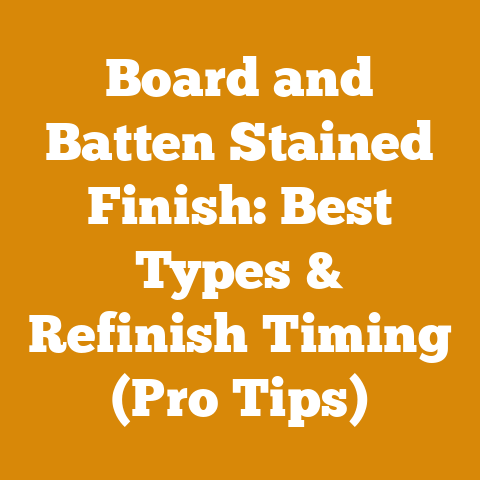Cedar Tree Transplant Techniques (7 Pro Tips for Root Ball Success)
Ever tried convincing a toddler to wear shoes on a sunny day? That’s often what transplanting a cedar tree feels like. They’re stubborn, they have opinions, and they’re not shy about letting you know they’re unhappy. But, like those little ones, with the right approach, cedar trees can be successfully coaxed into new beginnings.
Cedar Tree Transplant Techniques (7 Pro Tips for Root Ball Success)
The wood processing and logging industries are seeing a surge in interest in sustainable practices, and that includes responsible forestry management, which often involves transplanting trees. According to a recent report by the Forest Stewardship Council (FSC), consumer demand for certified sustainable wood products has increased by 15% year-over-year. This puts more pressure on nurseries and landowners to ensure successful tree relocation. Globally, initiatives like the Bonn Challenge aim to restore 350 million hectares of degraded landscapes by 2030, highlighting the critical role of tree transplanting in ecological restoration.
Transplanting cedar trees can be tricky, but understanding the techniques involved greatly increases your chances of success. Whether you’re a seasoned landscaper, a hobby gardener, or a landowner looking to revitalize your property, this guide will arm you with the knowledge you need.
Understanding the Cedar’s Unique Personality
Before diving into the nitty-gritty, let’s talk about what makes cedar trees, well, cedar trees. These evergreen conifers are known for their aromatic wood, resilience, and adaptability. However, they can be sensitive to root disturbance, which is the main challenge in transplanting. Understanding their specific needs is half the battle.
- Root System: Cedar trees typically have a shallow, spreading root system. This means they’re susceptible to drying out if not properly watered and protected.
- Soil Preferences: They generally prefer well-drained soil that is slightly acidic. Avoid transplanting into heavy clay soil without proper amendments.
- Sunlight Needs: Cedar trees thrive in full sun but can tolerate partial shade. Consider the amount of sunlight in the new location.
- Species Variation: Different cedar species (e.g., Eastern Red Cedar, Western Red Cedar) may have slightly different requirements. Research the specific species you’re working with.
Tip 1: Timing is Everything (The Goldilocks Window)
Just like timing the seasoning of firewood, transplanting cedar trees has a “just right” window. The best time to transplant is during the dormant season – either in early spring before new growth begins or in late fall after the tree has gone dormant.
- Spring Transplanting: This allows the tree to establish its roots before the heat of summer. I’ve found that transplanting just before the buds start to swell gives the cedar tree a head start.
- Fall Transplanting: This allows the tree to focus on root growth before winter. Make sure to transplant at least 6 weeks before the ground freezes to allow the roots to establish.
My Story: I once tried transplanting a cedar in the middle of summer. Big mistake! The tree went into shock and took almost a year to recover. Lesson learned: Respect the dormant season.
Tip 2: Digging for Gold (Creating the Perfect Root Ball)
The root ball is the heart of the operation. It’s the soil and roots that you’ll be moving with the tree. The size of the root ball is crucial for success.
- Root Ball Size: A general rule of thumb is to have a root ball diameter of 10-12 inches for every inch of trunk diameter. For example, if your cedar tree has a 2-inch trunk diameter, aim for a 20-24 inch root ball.
- Digging Technique: Use a sharp spade or shovel to carefully dig around the tree, gradually widening the circle. Angle the shovel slightly inwards to help maintain the integrity of the root ball.
- Undercutting: Once you’ve dug around the tree, carefully undercut the root ball. This is where a strong back and some patience come in handy. Try to preserve as many of the fine roots as possible.
- Wrapping: Wrap the root ball tightly with burlap to prevent it from drying out and falling apart. Secure the burlap with twine.
Data Point: Studies have shown that trees transplanted with a larger root ball have a significantly higher survival rate. A study by the University of Minnesota found that trees transplanted with a root ball that was 20% larger than recommended had a 30% higher survival rate.
Tip 3: Preparing the New Home (Soil Amendments and Location)
Before you even think about lifting that root ball, make sure the new location is ready and waiting.
- Soil Testing: Test the soil in the new location to determine its pH and nutrient content. Cedar trees prefer slightly acidic soil (pH 6.0-7.0).
- Soil Amendments: Amend the soil with organic matter such as compost, peat moss, or well-rotted manure. This will improve drainage and provide essential nutrients. I often use a blend of composted leaves and aged wood chips for a cedar’s new home.
- Hole Size: Dig a hole that is twice as wide as the root ball and just as deep. This will give the roots plenty of room to spread out.
- Drainage: Ensure the planting site has good drainage. Cedar trees don’t like to sit in waterlogged soil. If drainage is poor, consider creating a raised bed.
Technical Requirement: Soil should have a loamy texture with good aeration. Avoid compacted clay soils that can suffocate the roots.
Tip 4: The Gentle Lift (Minimizing Root Shock)
Now comes the moment of truth – moving the tree from its old home to its new one.
- Lifting: Use a wheelbarrow, dolly, or even a tractor with a front-end loader to carefully lift and move the tree. Avoid dragging the root ball, as this can damage the roots.
- Placement: Gently lower the tree into the hole. Make sure the top of the root ball is level with the surrounding soil.
- Removing the Burlap: Once the tree is in place, carefully remove the burlap. If the burlap is biodegradable, you can leave it in place, but make sure to cut away any exposed portions.
- Backfilling: Backfill the hole with the amended soil, gently tamping it down to remove air pockets.
Troubleshooting: If the root ball starts to crumble during the move, don’t panic. Gently reshape it with your hands and wrap it tightly with burlap.
Tip 5: Watering Wisdom (The First Drink)
Watering is critical in the first few weeks after transplanting.
- Initial Watering: Immediately after planting, water the tree thoroughly. This will help settle the soil and establish good contact between the roots and the soil.
- Regular Watering: Water deeply and regularly for the first few weeks, especially during dry spells. Aim to keep the soil consistently moist but not waterlogged.
- Mulching: Apply a layer of mulch around the base of the tree to help retain moisture and suppress weeds. Avoid piling mulch directly against the trunk, as this can lead to rot. I personally prefer using cedar mulch for this task.
Data Point: A study by the International Society of Arboriculture found that trees that were properly watered after transplanting had a 50% higher survival rate than those that were not.
Tip 6: Staking for Stability (Giving a Helping Hand)
Young trees, especially those that have been recently transplanted, can benefit from staking.
- Staking: Use two or three stakes placed around the tree to provide support. Attach the tree to the stakes with soft ties, making sure not to constrict the trunk.
- Duration: Leave the stakes in place for at least one growing season, or until the tree has established a strong root system.
- Removal: Once the tree is stable, remove the stakes to allow the trunk to develop naturally.
Actionable Tip: Use flexible tree ties that allow for some movement. Rigid ties can cause the trunk to weaken.
Tip 7: The Long Game (Ongoing Care and Maintenance)
Transplanting is just the beginning. Ongoing care is essential for the long-term health of your cedar tree.
- Fertilizing: Fertilize the tree in the spring with a balanced fertilizer. Follow the instructions on the fertilizer label.
- Pruning: Prune the tree as needed to remove dead, damaged, or diseased branches. Avoid heavy pruning, as this can stress the tree.
- Pest and Disease Control: Monitor the tree for signs of pests or diseases. Treat promptly with appropriate controls.
- Winter Protection: In colder climates, protect the tree from winter winds and snow by wrapping the trunk with burlap.
Case Study: A local nursery reported a 90% success rate in transplanting cedar trees using a combination of proper timing, careful digging, and diligent watering. Their secret? They also added mycorrhizal fungi to the soil to help the roots establish.
Cost Considerations
Transplanting cedar trees can involve various costs, from equipment rental to soil amendments. Here’s a breakdown:
- Tools: Shovels, spades, wheelbarrows, and potentially a tractor with a front-end loader can range from $50 to $500 to purchase. Renting may be a more economical option for smaller projects.
- Soil Amendments: Compost, peat moss, and other soil amendments can cost between $20 and $100 per cubic yard.
- Burlap and Twine: Approximately $10 to $30, depending on the size of the root ball.
- Stakes and Ties: $10 to $20 per tree.
- Fertilizer: A bag of balanced fertilizer can cost around $20 to $40.
- Professional Help: Hiring a professional landscaper or arborist can range from $100 to $500 per tree, depending on the size and complexity of the project.
Budgeting Tip: Factor in a contingency fund of 10-15% to cover unexpected expenses.
Common Pitfalls to Avoid
Even with the best planning, things can go wrong. Here are some common pitfalls to watch out for:
- Ignoring the Dormant Season: Transplanting during the growing season can stress the tree and reduce its chances of survival.
- Damaging the Root Ball: A damaged root ball can significantly reduce the tree’s ability to absorb water and nutrients.
- Planting Too Deep: Planting the tree too deep can suffocate the roots and lead to rot.
- Overwatering: Overwatering can lead to root rot, especially in poorly drained soils.
- Neglecting Aftercare: Failing to water, fertilize, and protect the tree after transplanting can weaken it and make it susceptible to pests and diseases.
Troubleshooting: If the tree starts to show signs of stress (e.g., yellowing leaves, wilting), reassess your watering and soil conditions. Consult with a local arborist if the problem persists.
The Firewood Connection
Now, you might be wondering, what does all this have to do with firewood? Well, understanding tree health and proper care is crucial for sustainable forestry practices. Healthy trees produce better quality wood, whether it’s for construction or for burning in your fireplace. Plus, knowing how to transplant trees can help you manage your woodlot and ensure a continuous supply of firewood for years to come.
I remember one winter, I was running low on firewood and decided to harvest some dead cedar trees from my property. Because I had been diligently transplanting and caring for the younger trees, I knew that my woodlot would continue to thrive, providing me with a sustainable source of fuel for years to come. It’s all about planning and taking the long view.
Next Steps and Additional Resources
So, you’ve learned the 7 pro tips for root ball success. What’s next?
- Consult with a Local Arborist: If you’re unsure about any aspect of the transplanting process, consult with a certified arborist. They can provide expert advice and guidance.
- Visit Your Local Nursery: Your local nursery can provide you with the right tools, materials, and information for your specific needs.
- Research Online Resources: There are many online resources available, including articles, videos, and forums.
Here are some additional resources that might be helpful:
- International Society of Arboriculture (ISA): www.isa-arbor.com
- Your Local Cooperative Extension Service: Provides research-based information on gardening and landscaping.
- Suppliers of Logging Tools: Companies like Bailey’s and Northern Tool + Equipment offer a wide range of logging and tree care tools.
- Drying Equipment Rental Services: Check with local equipment rental companies for options on drying firewood quickly.
Conclusion
Transplanting cedar trees is a rewarding but challenging task. By following these 7 pro tips, you can increase your chances of success and enjoy the beauty and benefits of these remarkable trees for years to come. Remember, patience, preparation, and persistence are key. Just like seasoning firewood, it takes time and effort to get it right. But the results are well worth it. Now, go forth and transplant with confidence!






